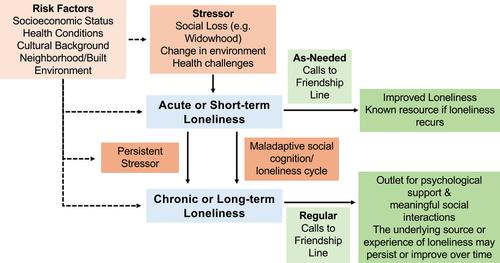The Role of Daily Calls to Telephone Companionship Lines for Older Adults Experiencing Chronic Loneliness
IF 4.8
3区 综合性期刊
Q1 MULTIDISCIPLINARY SCIENCES
引用次数: 0
Abstract
This study uses mixed methods to understand the experiences of daily versus nondaily callers to a telephone-based companionship line, the Institute on Aging Friendship Line, for loneliness. Baseline interviews of Friendship Line participants (n = 63) were conducted between October 1st, 2020, and April 30th, 2021, with follow-up interviews at 3 and 6 months. We tested the association of call volume (daily vs. nondaily) with chronic loneliness, defined as scoring 6+ points on the 3-item UCLA Scale (Range: 3–9 points) at two or more time points. In addition, we analyzed qualitative interviews of a purposive sample (n = 23) thematically. Daily callers were more likely to be chronically lonely than nondaily callers (61% vs. 18%, χ2 (1) = 11.5, p<0.001). Although daily callers reported high levels of chronic loneliness, they reported high satisfaction with and meaningful relationships through the Friendship Line (daily: 83% vs. nondaily: 61%, χ2 (1) = 2.9, p = 0.09). Daily callers described the importance of a long-term, evolving relationship with Friendship Line, whereas nondaily callers described the Friendship Line as an outlet for acute social needs, similar to an urgent care clinic. Taken together, results suggest the Friendship Line is an important source of support for older adults managing both chronic loneliness and occasional loneliness.

每天拨打陪伴电话对经历慢性孤独的老年人的作用
这项研究使用了多种方法来了解日常和非日常打电话给基于电话的友谊热线(老年友谊热线)的人的孤独感。在2020年10月1日至2021年4月30日期间对友谊线参与者(n = 63)进行基线访谈,并在3个月和6个月时进行随访访谈。我们测试了通话量(每天与非每天)与慢性孤独感的关系,慢性孤独感的定义是在三个项目的UCLA量表(范围:3-9分)上在两个或多个时间点上得分6分以上。此外,我们从主题上分析了一个有目的样本(n = 23)的定性访谈。每天打电话的人比非每天打电话的人更有可能长期孤独(61%比18%,χ2 (1) = 11.5, p<0.001)。尽管每天打电话的人报告了高水平的慢性孤独感,但他们对通过友谊热线建立的有意义的关系的满意度很高(每天:83% vs.非每天:61%,χ2 (1) = 2.9, p = 0.09)。每天打电话的人描述了与友谊热线建立长期、不断发展的关系的重要性,而非每天打电话的人则将友谊热线描述为满足紧急社会需求的出口,类似于紧急护理诊所。综上所述,研究结果表明,友谊热线是老年人应对慢性孤独和偶尔孤独的重要支持来源。
本文章由计算机程序翻译,如有差异,请以英文原文为准。
求助全文
约1分钟内获得全文
求助全文
来源期刊

Annals of the New York Academy of Sciences
综合性期刊-综合性期刊
CiteScore
11.00
自引率
1.90%
发文量
193
审稿时长
2-4 weeks
期刊介绍:
Published on behalf of the New York Academy of Sciences, Annals of the New York Academy of Sciences provides multidisciplinary perspectives on research of current scientific interest with far-reaching implications for the wider scientific community and society at large. Each special issue assembles the best thinking of key contributors to a field of investigation at a time when emerging developments offer the promise of new insight. Individually themed, Annals special issues stimulate new ways to think about science by providing a neutral forum for discourse—within and across many institutions and fields.
 求助内容:
求助内容: 应助结果提醒方式:
应助结果提醒方式:


